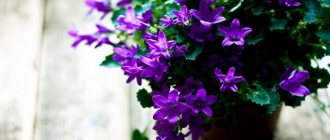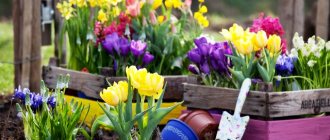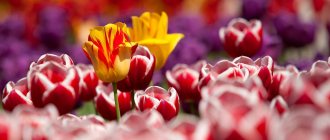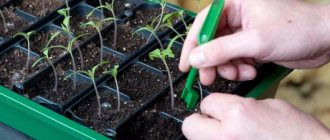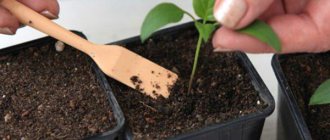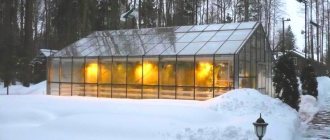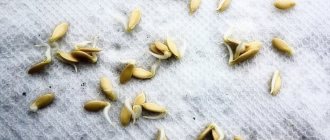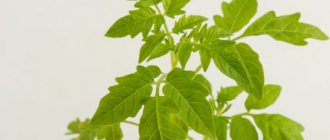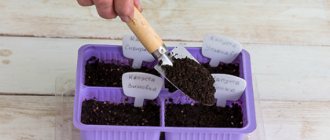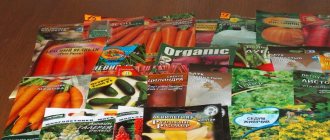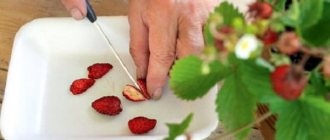Don’t know how to properly grow strong summer seedlings? Our article will help you avoid making mistakes and get a beautiful flower garden.
Using attractive annuals, you can create a bed of continuous flowering. To do this, the first step is to determine the optimal time for sowing seeds for seedlings. Plants that bloom within a couple of months after sowing (verbena, gatsania, lipweed, coleus, bluebell, pelargonium, sparkling salvia, fragrant tobacco, snapdragon, cineraria maritima) are sown in January-February. But mass sowing of annuals occurs in March and April.
Sowing dates for annual plants in central Russia
| Seed sowing time | Plant name |
| First half of March | Anemone, aster, anacyclus, seaside armeria, asparagus, adonis, Chinese carnation, gomphrena, kupena, kufeya, lacfiol, mirabilis, mesembryanthemum, euphorbia bordered, nolana, pyrethrum, sanvitalia, scabiosa, salpiglossis, platycodon, navel, helianthemum, aspen, primrose , soapwort, edelweiss, sage, immortelle. |
| Second half of March | Ageratum, arctotis, climbing azarina, brachycoma iberisolifolia, venidium, dianthus, helichrysum, godetia, dolichos, morning glory, cleome, lavatera, summer gillyflower, lobularia, nasturtium, nemesia, osteospermum, perilla, penstemon, Drummond's phlox, chrysanthemum, echinacea, echium. |
| First half of April | Arctotis, annual aster, basilisk, cottonweed, helipterum, iberis, kniphofia, xeranthemum, lobularia, fragrant mignonette, scabiosa. |
| Second half of April | Amaranth, marigolds, annual dahlia, datura, diascia, sweet pea, ornamental cabbage, clarkia, purslane, celosia, zinnia. |
Containers for flower seedlings
It is best to grow flower seedlings in separate pots, so as not to have to pick seedlings later. Such seedlings grow stronger and, as a rule, are not affected by rot.
Both small disposable cups and large boxes are suitable as containers for flower seedlings. The main thing is that there are holes made in the bottom of the container to drain excess water, and there is also a tray.
Seedlings of compact plants can also be grown in peat tablets or peat humus cups
Useful video
We recommend watching an interesting video about growing marigold seedlings without soil:
Each flower plant is individual, so each one has its own method of care. Experienced plant growers advise paying special attention to growing flower seedlings, since it determines whether the flower will grow healthy and delight with abundant flowering. It is also important to observe the timing of sowing and planting in the front garden, because each plant has its own period and flowering period.
Don't forget to share the material on social networks, leave comments!
Rate the article, share the material with friends on social networks, and express your opinion in the discussion below!
Soil for seedlings
Under no circumstances should you use soil in which indoor or container plants have already grown. For seedlings it is necessary to take new soil. If you want to save money, you can prepare the soil mixture yourself. At the same time, do not forget to disinfect it: heat it in the oven for an hour at 50°C.
The substrate for seedlings of most annuals should consist of turf and leaf soil, humus and sand, taken in equal proportions. Only some crops require a different soil composition. For example, for flowers susceptible to the formation of blackleg (ageratum, aster, gillyflower, lobelia, snapdragon, petunia, fragrant tobacco), you need soil that contains turf soil, peat and sand in a ratio of 3:1:1.
Dividing and planting rhizomatous perennials
In spring, gardening stores, nurseries, and private traders offer a wide range of rhizomatous perennials - flowering and decorative foliage plants. Hostas , heucheras , astilbes , small-flowered chrysanthemums , phlox , clematis, roses, peonies, sedums, speedwells , delphiniums , bush hydrangeas , spirea , cinquefoil , honeysuckle and others. The species and varietal diversity is amazing! To guarantee survival, it is better to buy seedlings with a closed root system, which are sold in containers or pots.
It is advisable to choose a place in your garden a couple of weeks before the intended planting, taking into account the plant’s requirements for environmental factors and prepare the soil.
In the spring (until mid-May), the perennials that have grown in the dacha are divided, but only those that will bloom in August and autumn: asters, helenium, goldenrod, rudbeckia, phlox, chrysanthemums. To divide, the bush is dug up entirely and cut into pieces with a knife, each of which should have 3-5 buds and a piece of rhizome with a good root lobe. The cuttings are disinfected with ash, dried in the open air and planted. The renewal buds are buried 3-5 cm. The daughter bushes are watered and mulched.
The mother plant can be carefully divided without digging: the soil is raked off on one side, part of the visible rhizome is cut off and separated
Many rhizomatous crops are characterized by a process of particulation , in which the mother bush disintegrates due to the destruction of the main root. The curtain breaks up into daughter plants, which no longer bloom as luxuriantly as before. This happens in the 3-5th year of the perennial’s life. To prevent the natural process of degeneration, the bush is divided every 2-4 years or the planting is renewed with new plants grown from seeds. Nielweed , kareopsis , forget-me-not , delphinium , and lupine are subject to particulation .
Sowing seeds for seedlings
Place drainage made of expanded clay, gravel or broken brick 1 cm thick at the bottom of the container. Then place a moist (but not too wet!) substrate so that about 2 cm remains to the top of the container.
Sow large seeds in pre-made furrows to a depth equal to three times the size of the seed, and lightly compact the soil. Sow medium-sized seeds in the furrows, but only lightly sprinkle them with soil (the layer should not exceed 0.5 cm). Mix very small seeds with dry sand, scatter them over the surface of the soil and water them with a spray bottle.
Cover the container with glass or plastic wrap and place in a warm place. Please note: until seedlings appear, the soil should always be slightly moist.
The optimal temperature for germination of seeds of heat-loving plants is 25-30°C, cold-resistant plants are 15-18°C
After germination, remove the glass or film and keep the plants at a temperature of about 20°C. When the seedlings grow up, sprinkle their stems a little with light soil and place the plants in a well-lit place with a temperature of 15°C.
Let's start with a seed
When sowing seeds, you need to have patience and endurance, since seed germination has different timing. If you use seeds collected from your own plants, then keep in mind that they may generally lose their viability if they do not have time to ripen or are stored incorrectly. In addition, there is always a risk that it will not be possible to obtain a plant with last year’s characteristics, since the selection of seeds also has its own subtleties.
The method of germinating seeds purchased in flower shops is indicated on the bags, which describe in detail the conditions for the successful cultivation of each plant. When purchasing, you need to monitor the expiration date and not buy discounted or expired seeds, otherwise you may not wait for germination at all.
Some plants are capable of very rapid germination, and seedlings can please you within a few days. For example, marigolds, marigolds, petunia, cleome, viola and many others.
Marigold
Cleome
There are also plants with a very long seed germination period, such as brugmansia, lavender, primrose, hellebores, lumbago, and most perennial plants. Various methods are used to stimulate the processes of seed pecking.
Brugmansia
Hellebore
Hardening off annual seedlings
2 weeks before planting in a flower garden or cold greenhouse, it is necessary to gradually accustom the seedlings to a lower temperature. To do this, take young plants out into the yard or onto the veranda every day. At first, keep them outside for only 2 hours, and then gradually increase the hardening time.
Start taking cold-resistant summer plants (for example, cineraria and antirrhinum) outside at an air temperature of 8-10°C, and to harden heat-loving plants, you should wait until the temperature reaches at least 12°C.
Please note: during hardening, seedlings must be protected from drafts and direct sunlight
Good lighting
Most of the annual flowers we grow come from tropical countries where daylight hours are 14 hours or more. On short winter days, seedlings need additional lighting with fluorescent lamps or special phytolamps in order to obtain high-quality seedlings.
Otherwise, the plantings will be pale, stretch out, the stem will become thin and the plant may get sick. The lamp is placed close to the crop (25-30 cm), the lamp is used at dusk for at least 6 hours, or, if more convenient, for three hours early in the morning and in the evening. The seedlings will immediately get stronger.
Planting flower seedlings in open ground
Flower seedlings are planted in the ground at the end of May - beginning of June, when the threat of return frosts has passed. It is better to transplant on a cloudy day or in the evening when the sun sets.
Before planting seedlings, prepare the soil in advance: loosen it, apply mineral fertilizers and humus, level the surface, make grooves or holes and water them. When moisture saturates the soil, plant the seedlings.
If you know any tricks and proven techniques for successfully growing seedlings of annual plants, share them with readers in the comments or on our forum.
Soil preparation
All floral and ornamental plants are demanding on soil.
In flower beds for annual and biennial flowering and ornamental plants, it should be a layer of at least 20-30 cm, with good subsoil. Flowers grow and develop normally only with a sufficient supply of macro- (nitrogen, phosphorus, potassium, calcium) and microelements (magnesium, iron, manganese, sulfur, copper, zinc, boron, molybdenum, etc.) and good soil structure. Before planting flower beds, the soil is improved - cultivated. The ideal soil for plants is fertile light loam, loose, airy, with healthy and beneficial microflora, with an acidity close to neutral. You can find out the nutrient content in the soil by doing a laboratory soil test. You can also find out the granulometric composition of the soil by conducting your own small study according to N.A. Kaczynski (Fig. 1).
Rice. 1. Indicators for determining the granulometric composition of soil (according to N.A. Kachinsky)
1 - solid cord, solid ring - clay; 2 - solid cord, rolled into a ring with cracks - heavy loam; 3 - solid cord, breaks when rolled into a ring - medium loam; 4 - a cord is formed, but is crushed when rolled into slices - light loam; 5 - cord rudiments - sandy loam; 6 - the cord does not form - sand.
Light loams (number 4) are optimal for plants.
If a ring or a ring with cracks forms (the shovel is difficult to enter), the soil is heavy loam. The addition of the health-improving leavening agent PuhoVita (4–5 liters per 1 m2) will improve the granulometric composition of the soil. PuhoVita contains agropor - natural aluminosilicates of sedimentary origin, natural phytobacteria and humic substances of fertility, as well as magnesium 10-14%, potassium 3-5%, calcium 1.2-2%, manganese 0.8-1%, iron 5.6 -6.5%, silicon 34-36%, etc. Thanks to the unique composition, PuhoVita improves the structure, increases aeration, air and moisture capacity of the soil and enriches it with natural humic substances of fertility and valuable nutrients.
If you have weeds such as sorrel and horsetail growing in your garden, that is, the soil is acidic, then liming is necessary. To do this, during spring or autumn digging, add 2 kg of deoxidizer per 6-10 m2 of soil. Lime-GUMI deoxidizer with boron is an organomineral fertilizer enriched with the microelement boron, as well as calcium, magnesium, nitrogen, phosphorus, potassium, fertile humus and natural growth vitamin. Gumi improves the supply of nutrients (macro- and microelements) to plants; After liming, heavy loamy and clayey soils become loose and airy. Lime applied in full dose is effective for 5–7 years.
If a cord does not form (numbers 4 and 5), the soil is loose and the shovel goes in easily, then most likely you have sandy loam or sandy soils. They are loose, but poor in nutrients, in addition, they have low moisture holding capacity. In this case, apply 5-6 kg/m2 of Bionex soft fertilizers or 70 g of Gumi-OMI.
The nutrients in the soil must be balanced. You should not overfertilize the soil with nitrogen - this can lead to fattening of plants: leaves and stems will grow excessively to the detriment of flowers. Fattening perennial plants do not overwinter well. Excess potassium makes it difficult to absorb calcium and magnesium, and excess phosphorus leads to phosphatization of the soil, which negatively affects the absorption of microelements by plants and leads to premature aging of plants and chlorosis. Excess copper limits the supply of iron to plants, and excess molybdenum limits the supply of iron and manganese. Therefore, you need to be very careful when applying fertilizers.
It is best to use organomineral fertilizers balanced in the content of macro- and microelements.
Adding Gumi-OMI UNIVERSAL - Vegetables, Berries, Flowers (0.7 kg per 10 m2) under digging will provide plants with balanced essential nutrients and improve the soil structure in your garden.
The edges of the flower bed should be at the level of the paths or slightly below and bordered by a lawn or various borders. This is done so that when watering the soil does not fall onto the paths. This is especially important if the paths are paved. If the soils are waterlogged, flower beds are made higher than the paths. The surface of the flower bed can be made flat or slightly elevated towards the center (5-10%).
Excellent fertilizer for roses - Gumi-Omi Roses
A pattern is applied to the planned and watered surface of the flower bed according to the layout drawing, using pegs, a tape measure and a cord. The pattern on the soil remains visible longer if you lightly sprinkle the lines with chalk. To avoid trampling the surface of the flower bed when laying it out, boards are placed on it.
Well-developed seedlings are planted in the budding phase, in cloudy weather or in the evening. Annuals are planted when the danger of frost has passed (in Bashkortostan approximately June 5-10). Biennials - violas, daisies, forget-me-nots and others can be planted in early spring, as soon as the soil is ready.
Plants prepared for planting should be well watered at least 4-5 hours before digging. Seedlings must be replanted with a clod of earth; dry earth crumbles, and wet earth sticks to the roots. Watering with OZHZ solution No. 2 (1 drop of Gumi + 5 drops of Fitosporin-M + 1 liter of water) will improve survival rate, providing the plant with nutrients and protecting it from fungal diseases.
When planting, use a scoop to make holes large enough so that the roots do not bend. Plants are planted slightly deeper than the root collar. The roots of the plants are squeezed tightly but carefully.
Immediately after planting, the flower garden is watered. The water should not be very cold. If the flowerbed is located on the lawn, the distance between the grass and flowers should be left at least 10 cm.
After planting, it is useful to sprinkle MULCH-LOUNDER Mother Earth Chernozem on the flowerbed. Mulch will serve as a fertilizer, delay the evaporation of moisture, prevent the formation of crust and the germination of weeds, and in addition, it will give the flowerbed a neat appearance. Contains macroelements: nitrogen - 40 mg/kg, phosphorus - 45 mg/kg, potassium - 40 mg/kg; organic matter - 60%.
After planting, the flowerbed is watered every other day, then once a week.
OZHZ School – Growing seedlings of flower crops using OZHZ technology
